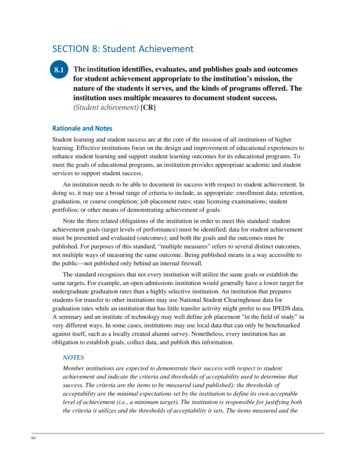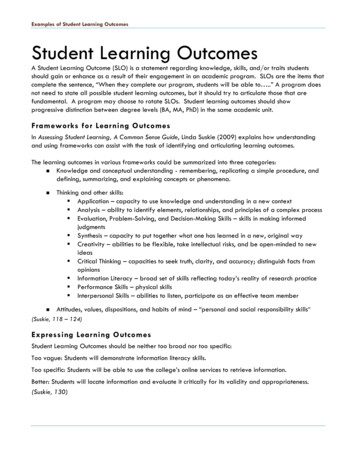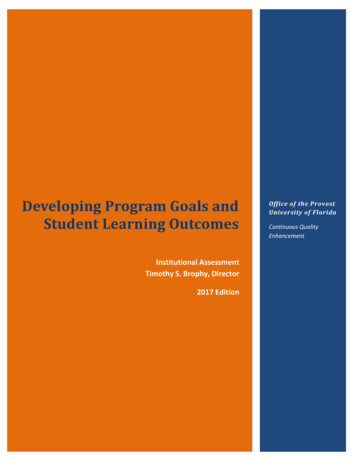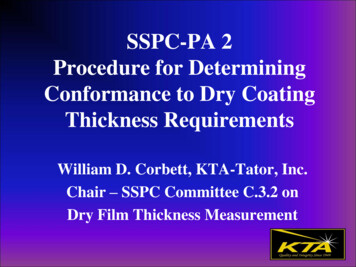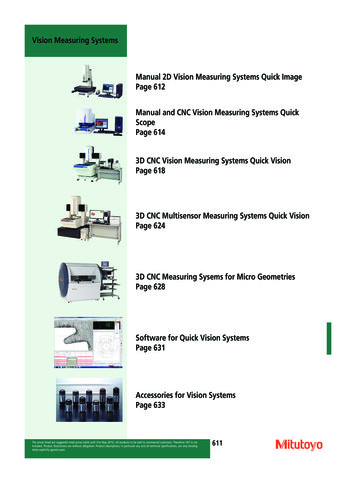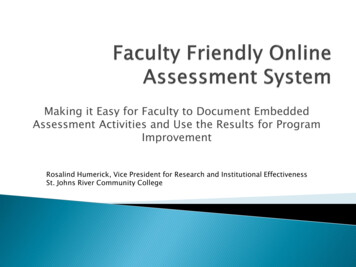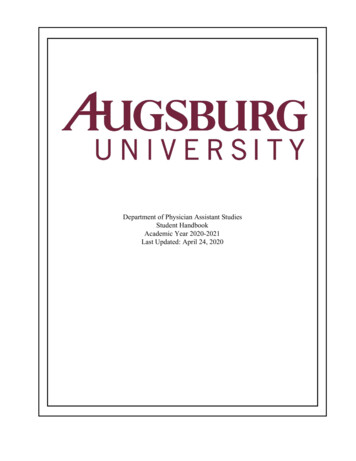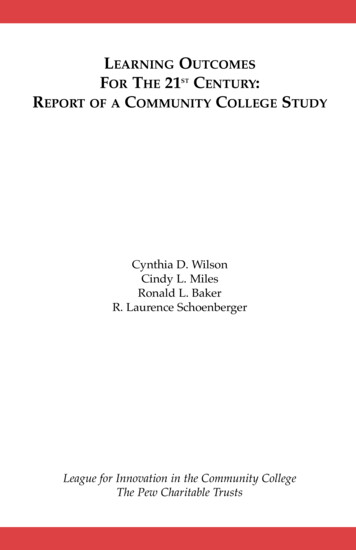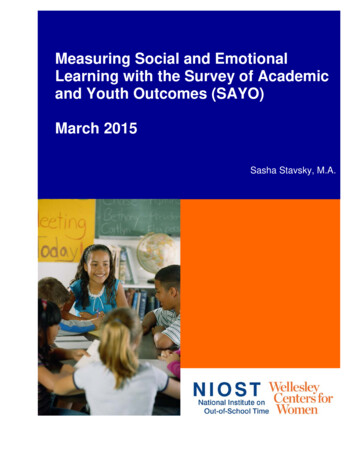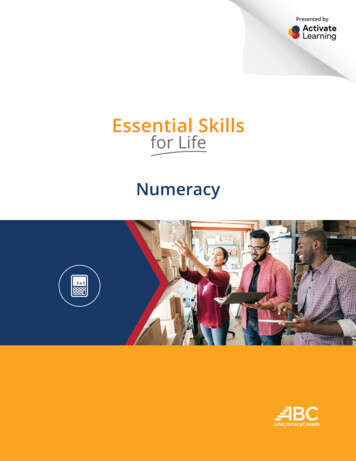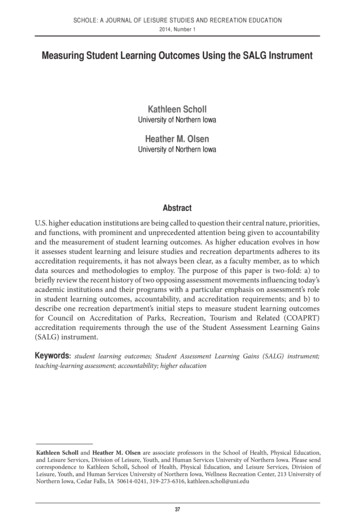
Transcription
SCHOLE: A JOURNAL OF LEISURE STUDIES AND RECREATION EDUCATION2014, Number 1Measuring Student Learning Outcomes Using the SALG InstrumentKathleen SchollUniversity of Northern IowaHeather M. OlsenUniversity of Northern IowaAbstractU.S. higher education institutions are being called to question their central nature, priorities,and functions, with prominent and unprecedented attention being given to accountabilityand the measurement of student learning outcomes. As higher education evolves in howit assesses student learning and leisure studies and recreation departments adheres to itsaccreditation requirements, it has not always been clear, as a faculty member, as to whichdata sources and methodologies to employ. The purpose of this paper is two-fold: a) tobriefly review the recent history of two opposing assessment movements influencing today’sacademic institutions and their programs with a particular emphasis on assessment’s rolein student learning outcomes, accountability, and accreditation requirements; and b) todescribe one recreation department’s initial steps to measure student learning outcomesfor Council on Accreditation of Parks, Recreation, Tourism and Related (COAPRT)accreditation requirements through the use of the Student Assessment Learning Gains(SALG) instrument.Keywords: student learning outcomes; Student Assessment Learning Gains (SALG) instrument;teaching-learning assessment; accountability; higher educationKathleen Scholl and Heather M. Olsen are associate professors in the School of Health, Physical Education,and Leisure Services, Division of Leisure, Youth, and Human Services University of Northern Iowa. Please sendcorrespondence to Kathleen Scholl, School of Health, Physical Education, and Leisure Services, Division ofLeisure, Youth, and Human Services University of Northern Iowa, Wellness Recreation Center, 213 University ofNorthern Iowa, Cedar Falls, IA 50614-0241, 319-273-6316, kathleen.scholl@uni.edu37
STUDENTS OUTCOMES AND THE SALG INSTRUMENTScholl and OlsenChanges and challenges facing higher education today are comparable in significanceto other periods of transformation in the nature of the American colleges and universities(Leveille, 2006). The advent of land-grant institutions through the Morrill Act of 1862challenged traditional and elitist American colleges to broaden the scope of their classicalcurriculum in order to democratize and open a higher educational system to a widerconstituent (Eckert, 2012; Turner, 1984). During the years following World War II, U.S.colleges and universities experienced another great transformation, when the researchuniversity evolved to serve a mass working and middle class population to meet Americanpostwar technical, economic, and social needs (Leveille, 2006; Trow, 2005). From 1955 to1970, the number of students attending American colleges and university rose from 2.5million over 7 million (Bowman, 2011). By 2009, 20.4 million students were enrolled in2- or 4-year colleges and universities (Snyder & Dillow, 2011). By 2019, enrollments areexpected to rise 9% for students under age 25, and a rise of 23% is expected for studentover the age of 25 (Snyder & Dillow, 2011). Continued enrollment growth, society andtechnology changes, and institutions redesigning themselves for increased universaland open access has created an ever more diverse and complex U.S educational system.In the haze of this current transformative period, U.S. higher education institutions areagain called to question their central nature, priorities, and functions, with prominent andunprecedented attention being given to accountability and the measurement of studentlearning outcomes (Brint, 2009; Leveille, 2006; Liu, Bridgeman, & Adler, 2012; Trow, 2005).The purpose of this paper is two-fold: a) to briefly review the recent history of twoopposing assessment movements influencing today’s academic institutions and theirprograms with a particular emphasis on assessment’s role in student learning outcomes,accountability, and accreditation requirements; and b) to describe one leisure and recreationdepartment’s initial steps to measure student learning outcomes for current Council onAccreditation of Parks, Recreation, Tourism and Related (COAPRT) accreditation andprogram review requirements through the use of the Student Assessment Learning Gains(SALG) instrument.Opposing Assessment IdeologiesThe demand for direct assessment of student learning and academic accountability isnot new. For years now, numerous stakeholders (employers, industry, taxpayers, tuitionpayers, governmental officials and state regulators, trustees, accreditation organizations,including those from within universities) have driven the current changes in studentassessment by questioning what constitutes quality undergraduate education and how itshould be measured (Arum, 2013; Leveille, 2006; Liu, 2011; Williams, 2008). In the 1970sand 1980s, critical voices regarding government waste, and ideologies of public responsibilityand sound fiscal investment circulated. National educational reports argued that toimprove undergraduate curricular pedagogy and to judge higher education effectiveness,states needed to intervene into college classrooms and collect evidence of student learning(Brint, 2009; Brittingham, 2009; Ewell, 2008). In response, a handful of colleges anduniversities voluntarily began designing systematic student learning assessment models.These early methods included a) abilities-based curriculum in which students demonstratemastery of specific interdisciplinary competencies by means of incremental performanceassessments, b) value-added testing using standardized examinations to evaluate academicachievement, and, c) performance funding scheme based on “a comprehensive departmentlevel assessment program structured around academic program review” (p.8). These early38
SCHOLE: A JOURNAL OF LEISURE STUDIES AND RECREATION EDUCATION2014, Number 1models are now foundational features of the current student learning assessment movement(Brint, 2009; Ewell, 2008).In the 1990s, stakeholders continue to fear loss of global economic competition, lossof leadership in young adults attaining postsecondary degrees, declining achievement ondomestic and international high-level literacy assessments, and high and rising tuition,textbooks, and student loan interest rates (Derthick, & Dunn, 2009; Ewell, 2008; Volkwein,2010a). As high-profile policy makers put more pressure on academic institutions, Statesmandated more evidence of student academic achievement. Gradually, state mandateswere facilitated by regional accrediting agencies. Even though regional accrediting bodiesare organized as independent, quality assurance agencies and directed by academics andformer academics, these agencies are subject to state and federal recognition. As a conditionof recognition, accrediting organizations began planning ways to directly access evidenceof student academic achievement through examining student learning outcomes (Brint,2009; Ewell, 2008). Distinct attitudes toward appropriate approaches to assessment andimplementation became more evident and an ideology division towards this new “culture ofevidence” within higher education continued to amplify (Arum, 2013; Ewell, 2008; Leveille,2006; Liu, Bidgeman, & Adler, 2012; Lubinescu, Ratcliff, & Gaffney, 2001; Volkwein, 2010a).Two distinct and opposing paradigms have been expressed as (a) the teaching-learningassessment approach; and, (b) the accountability approach (Brint, 2009; Ewell, 2008;Leveille, 2006; Volkwein, 2010a).Teaching and learning assessment approach. Rooted in foundation-supportedadvocacy organizations such as the American Association of Colleges and Universities(AAC&U), Carnegie Foundation for the Advancement of Teaching (CFAT), and theScholarship of Teaching and Learning (SoTL) colloquia, the teaching and learningassessment approach is viewed as an informative process to advance pedagogical principles(Brint, 2009). The teaching and learning assessment approach focuses on continuousimprovement using various qualitative and quantitative assessment methods to gather datafor internal purposes for the enhancement of student-centered learning and growth (Allen,2006, p.1). Suskie (2009) discussed assessment as an ongoing process to provide feedbackand guidance for faculty to reflect on their teaching process, to understand their impactand influence on students as to whether or not students learned, and use the results tosubsequently analyze how improve their students’ learning. By establishing clear teachinginfrastructure of identifying measurable outcomes, students have the opportunity toachieve the learning outcomes and meet course requirements through instructor feedbackand advice (Williams, 2008). In the SoTL approach, the academic is both the facilitator andthe assessor of student learning acting within the process of teaching and learning.The accountability approach. In contrast, the accountability approach primarilyevolved from state and federal accreditation recognition requirements calling for academicinstitutions to externally demonstrate to policymakers and the public of proper compliance,transparency, cost containment, and effective use of government funds in educating tobe worthy of continued support. In the midst of Elementary and Secondary Educationreform of NCLB, the Commission on the Future of Higher Education was established in2005 by the Department of Education (DOE) and led by appointed Secretary of EducationDirector, Margaret Spelling. In 2006, the Commission’s first report (the Spelling Report)noted significant problems throughout higher education that needed urgent reform (Brint,2009; Derthick & Dunn, 2009; Ewell, 2008; Liu, 2011; Liu, Bridgeman, & Adler, 2012).39
STUDENTS OUTCOMES AND THE SALG INSTRUMENTScholl and OlsenCiting a long list of educational failures, Spelling was especially critical of accreditationas being ineffective in providing reliable information about institutional quality and itsexcessive focus on institutional inputs while neglecting student learning outcomes (Ewell,2008; Spelling, 2006). The Spelling Report’s high-profile attention convinced a significantproportion of college and university presidents that a proactive response on accountabilitywas needed from higher education institutions (Ewell, 2008). Arum & Roksa’s (2011) recentresearch report on outcomes assessment, Academically Adrift, also made critical claimsabout the current state of U.S higher education. With today’s expectations for U.S. highereducation institutions and its programs to collect evidence of student learning, the primarygoal of the accountability assessment approach is to compare an institution’s ratings againstnational and peer-databases, transmitting official numbers to government agencies andguidebooks for student recruitment purposes on graduation and retention rates, measuresof student satisfaction and engagement and at least one standardized measure on students’critical thinking and communication proficiency. Comparatively, the accountabilityapproach places a greater reliance on standardized test to collect evidence compared todata collection methods of the internal, teaching and learning assessment approach (Ewell,2008).In the wake of the Spellings Commission report, there have been numerousorganizations formed to support the push toward assessment. Specifically, in 2008 theNational Institute for Learning Outcomes Assessment (NILOA) was formed to supportacademic programs and institutions to use assessment data to strengthen undergraduateeducation, internally communicate with faculty and programs, and externally communicatewith policymakers, students, and their families (NILOA, 2012). The NILOA presentshelpful and practical examples for faculty to determine whether students are really learningand truly understanding key educational concepts (Hutchings, 2011). Established in 2009,the Association for the Assessment of Learning in Higher Education (AALHE) was formed toassist interested parties in using effective assessment practice to improve student learning(AALHE, 2011). Similar to NILOA, AAHLE provides faculty with strategies and methodsfor using assessment to document and improve student learning. It is also important tomention The Higher Learning Commission has implemented an Academy for Assessmentof Student Learning (Higher Learning Commission, 2013). The Academy for Assessment ofStudent Learning offers institutions who are members of the Higher Learning Commissiona four-year sequence of events focused on improving student learning by building anassessment procedure for the institution to assess, confirm, and improve student learning(Higher Learning Commission, 2013).Role of Accreditation Associations and Organizations in Student AssessmentThe proliferation of land-grant, research, women, black, bible, art, work, and militaryschools, colleges, universities and academies during the late 19th century began theformation of regional accrediting associations in order to identify which institutions in theregion were legitimate (Brittingham, 2009). As accreditation organizations evolved, theyneeded a coordinating and accrediting body evaluator. Since 1949, a number of coordinatingorganization have existed, however, since 1996, the Council for Higher Accreditation(CHEA) has been the organization that today ‘accredits the accreditors’ (Winskowski,2012, p.23). Additionally, many accrediting organizations’ also had a relationship withthe U.S. Department of Education (USDE). This relationship evolved significantly afterthe President Lyndon B. Johnson signed into legislation the Higher Education Act (HEA)40
SCHOLE: A JOURNAL OF LEISURE STUDIES AND RECREATION EDUCATION2014, Number 1of 1965 that greatly expanded the federal financial aid available to assist students attendcolleges and universities. Early on, the government recognized accrediting organizationsas a reliable method to identify creditable institutions educationally worthy of the billionsof tax payer dollars annually invested in federal financial aid (Brittingham, 2009). HEA hasbeen reauthorized nine times since 1965 and is up for reauthorization again when it expiresat the end of 2013. Each time Congress reauthorizes, it makes amendments to its language,policies, and programs.Today, accreditation and quality assurance activities are focused on three major levels:institutional, programmatic, and individual (Volkwein, 2010a). At the institutional-levelor campus level, USDE, CHEA and the Accrediting Council of Independent Colleges andSchools (ACICS) sets the standards that regional, national faith-related, national-careerrelated and program accreditors must meet to be recognized. Regional accreditationreviews are typically conducted on a 10-year cycle. For academic institutions to beaccredited, they are expected to gather and present evidence that it is accomplishing itseducational goals and producing improvement both inside and outside of the classroom.Areas that educational institutions must assess include general education curriculum,teaching effectiveness, academic advisement, mentoring, experience of new students,and residential life. The old accreditation philosophy, most dominant before the 1980s,encourages institutions to maximize the quality of the inputs in order to guarantee thequality of the outputs. The new accreditation review process, growing in strength since1990, encourages institutions and their stakeholders to measure the outcomes in order tojudge the results or effectiveness of educational programs and the quality of the institution.Critics argue that too much focus on performance outcomes, like academic achievement,retention to matriculation or graduation rates, and faculty publications may not providethe information needed for internal program development, continual student educationalimprovement and enhancement (Brittingham; 2009; Volkwein, 2010a).The next level of quality assurance activity focuses at the programmatic-level.For example, there are over 90 specialized academic and vocation accrediting bodiesrecognized by either USDE or CHEA or both entities (Council for Higher EducationCoalition, 2013). These programmatic accrediting organizations, like the COAPRT and firstestablished in 1974 (Neipoth, 1998), scrutinize and accredit officially recognized specialtyacademic programs (medicine, law, business, teacher education, parks and recreation, etc.).Programmatic reviews typically occur every five years. Most higher education institutionsare supportive and eager for their programs to meet these standards set by professionalorganizations because “ accredited programs attract the best students, as well as federal andstate funding” (Volkwein, 2010a, p. 6).Finally, receiving certification as a Certified Park and Recreation Professional(CPRP), Certified Park and Recreation Executive (CPRE), Aquatic Facility Operator(AFO), Certified Playground Safety Inspector (CPSI), or Certified Therapeutic RecreationSpecialist (CTRS) through a professional organization such as the National Recreation andPark Association (NRPA) or National Council on Therapeutic Recreation Certification(NCTRC) are examples of individual-level credentialing for professionals and practitionerswithin a professional field.As higher education evolves in how it assesses student learning and leisure studies andrecreation education programs and department adheres to its accreditation requirements, ithas not always been clear, as a faculty member, as to which data sources and methodologiesto employ. What kinds of evidence are acceptable? How is the data to be used (enrollment41
STUDENTS OUTCOMES AND THE SALG INSTRUMENTScholl and Olsengrowth, student-centered learning and feedback of intellectual, personal or socialdevelopment, satisfy demands of external audiences, etc.)? What decisions are being madein relation to the data? And at what level (individual student, class, program, department,etc)? By clarifying the varied purposes of assessment, the Student Assessment of LearningGains (SALG) instrument may be one of many assessment practices that can assist facultyin gathering data for both teaching and learning feedback as well as accountability measuresfor external audiences.SALG Instrument FormatThe Student Assessment of Learning Gains (SALG) instrument is a free, onlineinstrument first developed in 1997 by Elaine Seymour while she was co-evaluator fortwo funded grants through the National Science Foundation. The instrument was revisedin 2007 to better reflect the goals and methods used in a broader array of disciplines.Traditional higher education student course evaluations ask students rank their satisfactionwith the faculty’s ability to create a learning atmosphere, evaluate fairly, and communicateeffectively. Alternatively, the SALG instrument seeks to aggregate data on student-reportedlearning outcomes within specific content areas e.g., student understanding, skills,cognition, attitudes, integration of learning, and motivation toward the subject in areas thatthe instructor identifies as relevant to the learning activities and objectives of the course(see Table 1).TableTable estions(SALG,Summary ofofSALG’sQuestions(SALG,2013)2013)SALG’s QuestionsExamplesHow much did the following aspects of the coursehelp you in your learning?Class and lab activities, assessments, particularlearning methods, and resourcesImportant course learning objectives andconcepts.As a result of your work in this class, what gains didyou make in your understanding?As a result of your work in this class, what gains didyou make in the following skills?As a result of your work in this class, what gains didyou make in the following?As a result of your work in this class, what gains didyou make in integrating the following?Writing technical reports, problem-solving,analyzing research, preparing budgetsEnthusiasm and attitude for the course or subjectarea.Incorporation and integration of information.Within each category of questions, students provide quantitative ratings on statementsabout the degree to which specific course attributes supported or contributed to theirlearning. Each category of questions also allows students to include written responsesabout the course focus, learning activities, content, and materials. As the course instructorcustomizes their assessment instrument, SALG allows the flexibility to modify, add,and delete sub questions. Instructors can use the instrument for baseline, formative, or42
SCHOLE: A JOURNAL OF LEISURE STUDIES AND RECREATION EDUCATION2014, Number 1summative purposes. The SALG site currently reports 8,933 instructors have used theinstrument, 4,874 instruments have been developed, and 187,248 students have respondedto the instrument (SALG, 2013).Implementation of SALGIn the fall of 2011, the SALG Learning Instrument was initially incorporated intotwo required undergraduate leisure, recreation, and park courses at a midwest university:(a) Leadership in Leisure, Youth, and Human Services, and; (b) Research and Evaluationin Leisure, Youth, and Human Services. At the time, the SALG learning instrument wasselected because the university’s Office of the Executive Vice President and Provost soughtfaculty to administrate the SALG instrument to students. The timing was fortuitous as itcoincided with the upcoming 2013 COAPRT accreditation changes for undergraduateprograms in the field of recreation and parks (NRPA, 2013).Leadership in Leisure, Youth, and Human Services is one of the first courses studenttake who are interested in the major. The average class size is approximately 30 students.The SALG instrument was first implemented in two course section during the spring of2012, then again in the fall of 2012 and spring 2013. To date, 121 undergraduate studentswho have been taken Leadership in Leisure, Youth, and Human Services have completedthe instrument. The Leadership in Leisure, Youth, and Human Services course learningoutcome is to provide students with the principals, theories, and techniques for effectiveleadership of programs, activities, employees, and volunteers. The questions developedfollowed the SALG framework of categories supporting student understanding, skills,attitudes, integration of learning, and professional practice with the concept of leadership.The instrument was given prior to start of the instructor facilitating course content (baseline data used as a pre-survey) and again after the course was completed (post-survey).Three semesters of pre-post data were collected in the Research and Evaluation inLeisure, Youth and Human Services course using the SALG instrument: fall 2011, spring2012, and spring 2013. This course provides an overview of the processes of research andevaluation as encountered in leisure services and has three major course prerequisitesprior to enrollment. Major students typically take this required course when they havereached senior status with 25–30 enrolled each semester. The course learning outcome isfor students to be able to successfully collect, analyze, synthesis, and interpret research dataand report findings and conclusions regarding the process and outcomes of leisure, youthand human service programs. The online pretest was available to students for 12 days atthe start of the semester. Students completed the posttest through the SALG website thelast two weeks of the semester. Typically, one would conduct a paired t-test with a pre-postdesign. However, the SALG site only identifies the individual students who have respondedto the instrument and does not provided the instructor the ability to link a specific studentwith their individual responses. Therefore, an independent t-test was used to assess preand post-test student learning gains on student conceptual understanding, research andevaluation skills, attitude toward the topic, and integration of learning. Differences betweenthe three Research and Evaluation courses and selected attributes were identified by usingANOVA analysis by uploading SALG data into Statistical Packages for the Social Sciences(SPSS). Only the Research and Evaluation Course data is presented in this paper as anexample for those interested in using the SALG instrument for measuring student learningoutcomes because similar data analysis was also completed for the leadership course.43
STUDENTS OUTCOMES AND THE SALG INSTRUMENTScholl and OlsenResults from Research and Evaluation CourseDemographic data was not collected yet there was a 64%–100% response ratedepending on the data collection period. Fall 2011 course had 26 students enrolled, and 23students completed the pretest and 24 students completed the posttest. In Spring of 2012,25 students were enrolled in the course and 20 students completed the pretest, with 16students completing the posttest. Most recently, 27 students were enrolled in the Spring2013 course, and 24 completed the pretest and 27 completed the posttest. To get a 100%response rate, faculty designated class time while in computer lab on the last day of thesemester to complete the SALG evaluation at the same time as the University’s traditionalstudent evaluation form was administered.Baseline and Summative ResultsStudent conceptual understanding of course content. In comparing the mean score ofthe pretest to posttest score, by combining all three semesters of students (n 67) and usingan independent-samples t-test, there was a significant increase in students reporting contentlearning of developing, implementing, and reporting research and evaluation projects (p. 01). A one-way ANOVA was also conducted to compare differences between one group ofstudents’ baseline understanding of topic content compared to a different semester cohortof students’ understanding. Results found that there was not a significant difference in oneclass pretest mean score compared to a difference semester course. Likewise, no significantdifferences were found between semester course post-scores. Table 2 illustrates, for eachsemester, the students’ conceptual baseline and summative understanding of the specificlearning goals for the Research and Evaluation in Leisure, Youth and Human Servicescourse.Student development of research and evaluation skills. The course skills involvedstudents reviewing professional journals, narrowing the focus of evaluation project,developing a quantitative survey, designing the appropriate sampling method, collecting,coding, analyzing and reporting the data in a written report. Each semester, studentsindicated that they significantly increased their research and evaluation skills in thisarea (p. 01) (see Table 3). Additionally, a one-way ANOVA was conducted to comparedifferences between one group of students’ baseline research skills compared to a differentsemester cohort of students’ skills in nine skill areas (see Table 3). Although results foundno significant difference in one class’ pretest mean score compared to a difference semestercourse in eight of the nine research skills, the students enrolled in the 2012 spring semestercourse had significantly higher post-scores for their perceived ability to design validsurvey or interview questions that align with my research and evaluation objectives (F(2,64) 5.374, p .007).Student attitude about the topic. Each semester, students were asked to identify theirconfidence in understanding and conducting evaluation projects. Independent-samplest-test of each semester cohort found that the confidence significantly increased over thesemester (see Table 4). On the other hand, their enthusiasm and interest in taking futureclasses in the subject area did not significantly change. A one-way ANOVA was conducted tocompare differences between semester students’ baseline and summative attitudes towardsconducting research and evaluation project. Fall semester 2011 students had significantlyless enthusiasm about the course subject matter that the Spring 2013 cohort (F (2, 64) 5.308, p. 007). On the other hand, there was no significant post-score difference betweenthe three semester courses. Open-ended responses from the summative survey indicated44
SCHOLE: A JOURNAL OF LEISURE STUDIES AND RECREATION EDUCATION2014, Number 1that a number of students were apprehensive, nervous, or uninterested about the coursetopic while other students showed interest.Table22.TableStudentConceptualConceptual ofPre-PostPre-PostSemesterResultsPresently, I understand the followingconcepts .How to develop a project that systematicallyevaluates leisure programs and servicesHow to systematically collect and analyze datathat is appropriate for my research evaluationprojectUnderstanding how to report my results and makeappropriate recommendation based on the dataresultsResearch and evaluation ethicsHow the concepts we will explore in this classrelate to my career in this subject areaHow ideas we will explore in this class relate tomy career outside of this subject areaHow studying this subject helps me to addressreal world issues and develop the skills I need inthe Leisure, Youth and Human ServicesprofessionF11pretestF11posttestSp 12pretestSp 85**(.72)Note: Likert Scale - 1 not applicable; 2 not at all; 3 just a little; 4 somewhat; 5 a lot; 6 a great deal)*p .05. **p .01. Standard Deviations appear in parentheses below the means.TableTable 33
2- or 4-year colleges and universities (Snyder & Dillow, 2011). By 2019, enrollments are expected to rise 9% for students under age 25, and a rise of 23% is expected for student over the age of 25 (Snyder & Dillow, 2011). Continued enrollment growth, society and technology changes, and institutions redesigning themselves for increased universal
